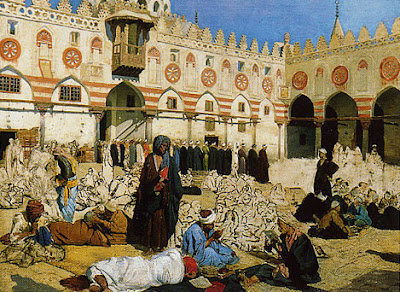1855 born in Vienna, Austria.
1872-1875 After high school, he entered the Academy of Fine Arts to study Classical painting with Anselm Feuerbach (1875-1877)
1877 When Feuerbach retired as a teacher, Deutsch and some others students attempted to enter the class of Leopold Carl Müller, who had moved to Paris in 1876, but were refused entry.
- 1878 Deutsch was accepted.
- 1880 Deutsch breaks his contacts with Vienna
- 1894 after making a name for himself in Paris he showed "The eunuchs"at the Künstlerhaus in Vienna.
- Deutsch continued his studies while taking lessons with the history influential painter Jean-Paul Laurens. Jean-Paul also introduced his most gifted students to Parisian buyers.
- He established his own studio at Rue Le Pelletier in Paris.
- 1879 Deutsch entered for the 1st time a portrait in the Salon competition.
- 1880 "Dona Joan Bohorques, Agony of the Inquisition was shown. A piece that suggest the influence of Laurens.
- 1881 His first recorded Orientalistes painting is created
- 1882 Painting of 'The Domino Players' completed (Die Dominospieler (les joueurs de dominos
- 1883 he exhibits a now lost piece to the Salon of French Artists under the title "An Orientalist Amateur.
- 1883 Painting of 'The Musician' completed
- 1883 Painting of 'The Answer'completed
- During this time Deutsch's work goes through an evolution. Although the subjects remain almost the same, he slowly turns from group paintings to that of capturing unique characters, from depicting secular places to that of beautiful palaces and places of worship.
- 1885 Deutsch found a new studio. During his career he was to have several studios throughout Paris and the South of France. He kept a vast amount of objects collected during his travels, such as tiles, furniture, arms, pipes, fabrics, and costumes. Like many of his contemporaries, the artist made use of photography to ensure archaeological accuracy in his painted renderings of local architecture, tile and ablaq stone work, and the traditional mashrabiyyah woodwork. This time also marked an era of great productivity and forays into a post-impressionistic style. Always the perfectionist, his work is characterized by exact attention to detail.
- 1885 Painting of
A Sentinel completed
- 1885 Painting of 'News from Sudan'completed
- 1886 Deutsch traveled to Egypt for the 1st time
- 1886 Painting of 'The Orange Sellers'completed
- 1886 Painting of
The Sherbert Vendor completed
- 1887 Painting of 'The hour of Prayer'completed
- 1888 Painting of "Snake Charmers'completed ("Snake Charmers" - Die Schlangenbeschwörer (Les charmeurs de serpents) shows a lively looking group of people)
- 1890 Deutsch traveled to Egypt for a 2nd time. These trips allowed him to gather subjects and motif for his work. Just like his friend Rudolf Ernst, Deutsch enlisted photographers from photography studios in Cairo.
- 1890 Painting of 'Court of El Azhar University, Cairo' completed
- 1891 Painting of
The Healer completed
- 1892 Painting of
The Palace Guard completed
- 1893 Painting of 'The Emir's Guard' completed
- 1893 Painting of
The Palace Guard completed
- 1894 Painting of
The Scribe completed
- 1896 Painting of
The Scribe completed
- 1896 Painting of 'Chess Players' completed (Les Joueurs d'échecs)
- 1897 Painting of
The Philosopher completed
- 1898 Deutsch traveled to Egypt for a 3rd time
- 1898 Painting of 'Prayer at the Tomb'completed
- 1900 Painting of
Palace Guard completed
- 1900 Painting of 'Leaving the Mosque'completed
- 1900 Won the Gold Medal at the Paris Salon in Paris for being a prolific painter for forty years.
- 1901 Painting of
The Learned completed
- 1902 Painting of
Interior of Mosque completed
- 1902 Painting of
Palace Guard completed
- 1903 Painting of 'The Harem Watchman'completed
- 1906 Painting of
Morning Prayer completed
- 1906 Painting of 'The Narghil Smoker'completed
- 1911 Painting of
The Scribecompleted
- 1914 With the break out of the First World War, he was forced to leave Paris.
Although his whereabouts during this time are not know, it is recorded that he did travel to North Africa for a time.
- 1919 At the first after war Salon he had obtained French citizenship and started to sign his name as Louis Deutsch
- 1923 Painting of
At Prayer completed
- 1927 Painting of
The Fortune Teller completed
- 1932 Painting of
Musical Interlude 1932 completed
- 1935 Unmarried and withdrawn from the world, he died on April 9th 1935 in Paris
It is said that Rudolf Ernst remained one of his closest friends.
?
Market Scene?
Sharia El Sanadkyeh?
Before Prayer?
An Arab with his Servant?
Sahleb VendorLudwig Deutsch, always the perfectionist has throughout his career aimed to perfect his photo realistic technique and to offer variety through the sparkling ways he has treated his canvases. Despite the exactness in the details, there is also evidence that he aimed to convey cultural relevance. Some thing do repeat within the different paintings, such as certain accessories and models, who without doubt were Arabs or Africans living in Paris. One can wonder if some of the Eastern compositions of Ludwig Deutsch were not entirely workshop inventions, yet the colors of the architectural details are in accordance with reality and leave no doubt that he has been influenced by his observations in the East.
 Unloading Watermelons
Unloading Watermelons


















